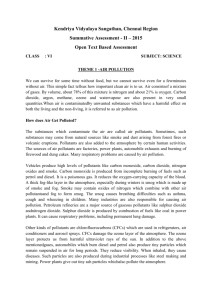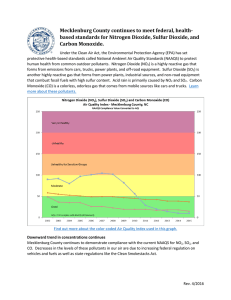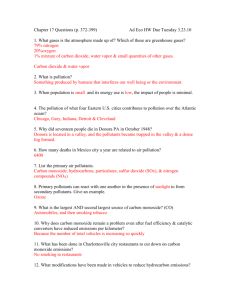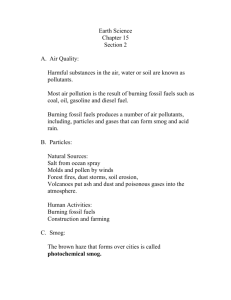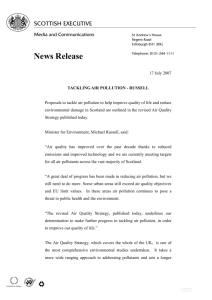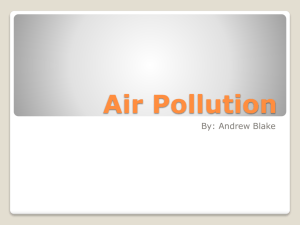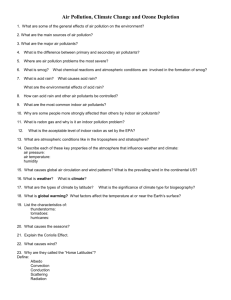Lesson 2 Air Pollution
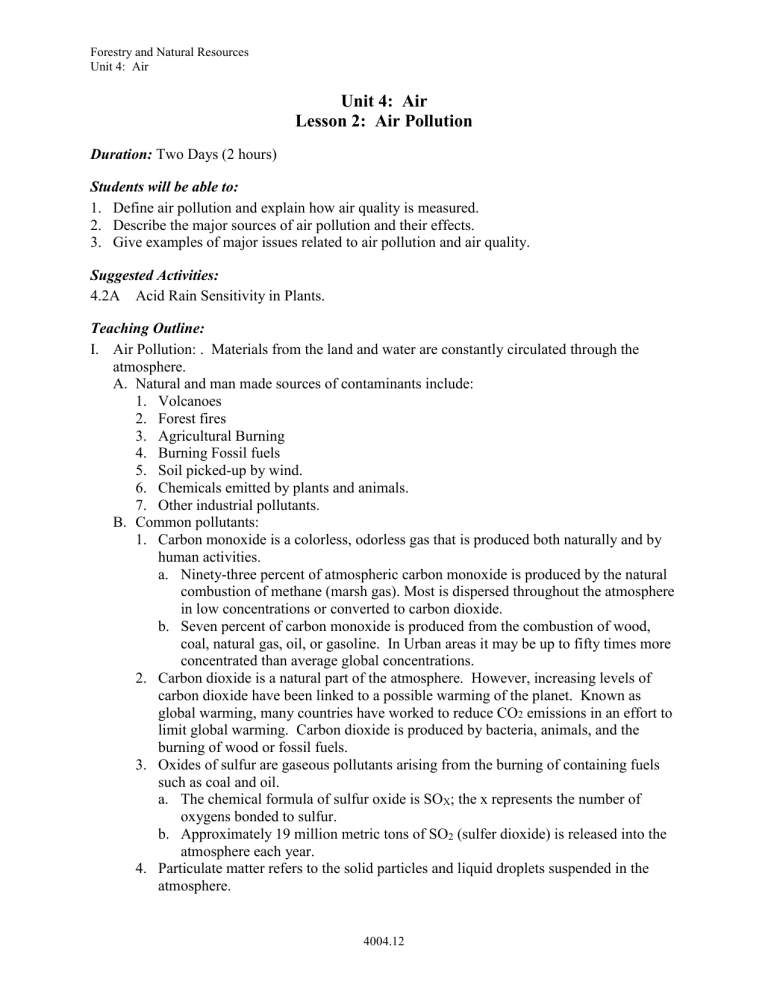
Forestry and Natural Resources
Unit 4: Air
Unit 4: Air
Lesson 2: Air Pollution
Duration: Two Days (2 hours)
Students will be able to:
1.
Define air pollution and explain how air quality is measured.
2.
Describe the major sources of air pollution and their effects.
3.
Give examples of major issues related to air pollution and air quality.
Suggested Activities:
4.2A Acid Rain Sensitivity in Plants.
Teaching Outline:
I. Air Pollution: . Materials from the land and water are constantly circulated through the atmosphere.
A. Natural and man made sources of contaminants include:
1. Volcanoes
2. Forest fires
3. Agricultural Burning
4. Burning Fossil fuels
5. Soil picked-up by wind.
6. Chemicals emitted by plants and animals.
7. Other industrial pollutants.
B. Common pollutants:
1. Carbon monoxide is a colorless, odorless gas that is produced both naturally and by human activities. a. Ninety-three percent of atmospheric carbon monoxide is produced by the natural combustion of methane (marsh gas). Most is dispersed throughout the atmosphere in low concentrations or converted to carbon dioxide. b. Seven percent of carbon monoxide is produced from the combustion of wood, coal, natural gas, oil, or gasoline. In Urban areas it may be up to fifty times more concentrated than average global concentrations.
2. Carbon dioxide is a natural part of the atmosphere. However, increasing levels of carbon dioxide have been linked to a possible warming of the planet. Known as global warming, many countries have worked to reduce CO
2
emissions in an effort to limit global warming. Carbon dioxide is produced by bacteria, animals, and the burning of wood or fossil fuels.
3. Oxides of sulfur are gaseous pollutants arising from the burning of containing fuels such as coal and oil. a. The chemical formula of sulfur oxide is SO
X
; the x represents the number of oxygens bonded to sulfur. b.
Approximately 19 million metric tons of SO
2
(sulfer dioxide) is released into the atmosphere each year.
4. Particulate matter refers to the solid particles and liquid droplets suspended in the atmosphere.
4004.12
Forestry and Natural Resources
Unit 4: Air a. Particulates may remain in the atmosphere from a few seconds to many months. b.
The sources of particulate matter are many and diverse; they include power plants, iron and steel mills, auto exhaust and fine particles of sand thrown aloft by car tires.
5. Hydrocarbons are complexes of hydrogen and carbon that can react with nitrogen oxides in the presence of sunlight to form photochemical smog. a.
In large urban areas approximately 200 different types of hydrocarbons may be generated by human activities. b.
Sources of atmospheric hydrocarbons include the evaporites from carburetors or gas tanks, and unburned particulates from the exhaust pipes of motor vehicles.
6. Oxides of nitrogen have the chemical formula NO
X
(x represents the number of oxygen bonds to nitrogen) and are predominantly of two types. a. Nitric oxide (nitrogen monoxide) is the first nitrogen oxide to form. It’s chemical formula is NO. Nitric oxide combines with hemoglobin in the blood 300,000 times faster than oxygen and in high concentrations can lead to asphyxiation. b. Nitrogen dioxide is a brown-reddish gas with a pungent, choking odor. It is a component of photochemical smog and forms an unpleasant looking urban brown haze. Nitrogen dioxide is created during the combustion of fuels where the high temperatures cause atmospheric nitrogen (N
2
) and oxygen (O
2
) to combine.
7. Ozone is a colorless gas that is the major constituent of the photochemical smog at the Earth’s surface. It can create a brownish haze on hot summer afternoons. a. The production of ozone is light dependent and occurs in the lower part of the atmosphere where oxygen combines with hydrocarbons and nitrogen oxides. b.
Sources include vehicles, factories, landfills, gas stations, agricultural and farm equipment. The peak production of photochemical smog occurs between noon and four pm; it stops altogether after sunset.
8. Lead and its compounds can adversely affect human health through ingestion. a.
Lead exist in the atmosphere as particulates of solid matter suspended in the air. It may ingested indirectly through soil particles, dust, or contaminated water, or inhaled directly from the air. b. The sources of lead include coal combustion, car battery plants, and the combustion of garbage containing lead products.
9.
Cloro-flurocarbons are a product of aerosol sprays, refrigeration gasses. These chemicals have been linked to the destruction of the ozone layer.
C. Indoor air pollutants are contaminants emanating from products found in the household; furniture, carpets, particle board, and plywood are a few of the many contributors. In many homes in the United States, nitrogen dioxide, carbon monoxide, and hydrocarbons such as benzene, are two to seven times greater than outdoor concentrations.
1. Formaldehyde is a carcinogen (cancer causing pollutant) found in the foam insulation and furniture of homes. It can cause eye irritation, nausea, and respiratory problems.
Although OSHA has set minimum acceptable levels for formaldehyde at 3ppm, many homes are well above this level because of poor air circulation, small air volume, and a high concentration of formaldehyde containing materials (i.e. furniture).
4004.13
Forestry and Natural Resources
Unit 4: Air
2. Radon is a product of the decay of radium in natural soils. It is often sucked into homes through cracks in foundations overlying radium rich soil and rocks. Radon gas is odorless, colorless, and tasteless and can decay into lead and polonium. The EPA estimates that 20,000 of 130,00 deaths by lung cancer in the US each year can be attributed to radon gas. This gas along accounts for 55% of the radiation dose the average American sustains each year.
II. Effects of air pollutants: Air pollutants have deleterious effects on materials, organisms and human health. In addition, climatic and topographic factors influence the duration, concentration, and severity of local air contamination events.
A. Factors affecting air pollution concentrations: thermal inversions
1. Thermal inversion: The rapid cooling of air during the night results in a ‘cap’ of warmer air above. This traps pollutants in the cold air below. Horizontal winds stretch the pollutants over a large area. The inversion usually dissipates by late morning; the pollutants being vertically dispersed.
2. Subsidence inversion: A high pressure air mass stalls over an area and sinks toward the ground. This dense, static air inhibits the disbursement of pollutants. The North
Pacific high moves over Los Angeles and Oakland, often condensing great fogs that combine with pollutants to form smog.
3. Dust Domes: A shroud of pollutants forms as a result of marked temperature differences between an urban area and the surrounding countryside. The comparatively vegetationless urban landscape may be 20
0
C (27
0
F) warmer. As a result, pollutants over a city are carried upward by rapidly expanding, heated air.
Winds spread the pollutants until they are impeded at the interface between contrasting air temperatures; forming a ‘dome’ of particulate matter that may extend for miles from the urban area that caused it
B. Effects on climate: High concentrations of air pollutants can affect climatic conditions by reducing sunlight penetration through the atmosphere, affecting the formation of clouds, and altering precipitation levels.
1.
Moisture from industrial smoke stacks, cooling towers and motor vehicles leads to the formation of clouds above cities, especially during the winter. Soot and dust make excellent condensation nuclei, attracting the tiny moisture droplets that form clouds.
Precipitation actually increases downwind from an urban center; there are more rainy days during the work week than on the weekend.
2. Decreased air temperatures are correlated with the blockage of sunlight by high concentrations of particulate matter in the atmosphere. For example in 1883, the eruption of Krakatoa released 800 million metric tons of ash and debris into the air causing a cooling trend in the US.
C. Effects on Human Health: Roughly 40,000 to 50,000 people die each year from air pollution related illnesses; this is equivalent to the total US casualties during the Vietnam
War.
1. Patterns of air pollution. a. Air pollution events occur in densely populated areas. b. Air pollutants are concentrated in heavily industrialized centers.
4004.14
Forestry and Natural Resources
Unit 4: Air c. Topography is a critical component affecting the severity of the event. d. Air pollution events may be compounded by an accompanying fog. e. A thermal inversion may trap pollutants close to the ground.
2. Health Affects: a. Chronic bronchitis: Sulfur dioxide and nitrogen dioxide are the culprits, causing irritation to the bronchial tubes. Symptoms include mucus buildup, a persistent cough, and difficulty in breathing. Photochemical smog is particularly high in nitrogen and sulfur dioxides. b. Emphysema: Normally, the respiratory membrane surface is equivalent to the surface area of a tennis court (300 million air sacs). Sulfur dioxide, nitrogen dioxide, and ozone cause an increase in the size of the air sacs (alveoli) which effectively reduces their respiratory surface area. The overall elasticity of the lungs is destroyed; up to 50 percent of the lung tissue may be damaged before a victim is aware of the problem. Symptoms include a difficulty in exhalation, cyanosis of the skin and an increased heart rate. c. Lung Cancer: Carcinogens or cancer causing agents include benzopyrene, asbestos, nickel, and beryllium. They are found in building products, household items (furniture), cigarette smoke, and coal smoke. A surprisingly high concentration of benzopyrene occurs in charcoal briquette barbecues; one smoked steak is roughly equivalent to smoking 600 cigarettes. d. Carbon monoxide poisoning: Carbon monoxide combines 210 times more readily with hemoglobin than oxygen. Exposure to 80 ppm of carbon monoxide for eight hours is equivalent to the oxygen starvation from one pint of blood loss. Carbon monoxide poisoning from automobile combustion, cigarette and pipe smoke causes headaches and drowsiness, and may be implicated in accidental highway deaths due to poor ventilation of exhaust fumes.
3. Other effects: a. Trees and crops may be affected by air pollutants that cause chlorosis or the yellowing of the leaves and a disruption in carbon fixation. Culprits include ozone, sulfur dioxide, sulfuric acid, and nitric acid. The lowering of soil pH from acid precipitation reduces the uptake of nutrients by plants. b. Damage to metals, stone, concrete, clothing, rubber and plastic is directly related to contaminants in the air. The typical culprits are sulfur dioxide, sulfuric acid, ozone (photochemical smog), and nitric acid (HNO
3
). Damage to crops and materials alone amounts to roughly $10 billion dollars a year.
4004.15
Forestry and Natural Resources
Unit 4: Air
Acid Rain Sensitivity in Plants
Laboratory Exercise 2A
Purpose:
The purpose of this activity is to observe the effects of acid rain on plants in a simulated experiment using vinegar or lemon water.
Activity Directions:
1. Each group will fill one milk jug or container with one gallon of tapwater. Label the jug or container as ‘Tapwater.’
2. Each group will fill one jug with one pint of vinegar and top off with 7 pints of tap water.
Label this second jug as “Slightly Acidic.”
3. Each group will fill a third jug with 2 pints of vinegar and 6 pints of tapwater. Label this jug as “Highly Acidic.”
4. Place plants in the same environment where they receive the same amount of sunlight and heat. Label each plant with corresponding “Tapwater,” “Slightly Acidic,” and “Highly
Acidic.”
5. Groups will water each plant, with equal amounts of the water/solutions, as needed, with corresponding water/solutions, in the jugs. Supervision may be required to make sure the plants receive corresponding water/solution each time.
6. Continue watering for several weeks while taking observation notes.
7. Make observation notes and answer questions on the Activity Handout lab sheet.
Materials Needed:
1. Three one gallon containers (milk jugs will work).
2. One pint of vinegar or lemon water per group.
3. Three potted plants per group (suggested plants: alfalfa, beans, lettuce, or radish).
4. Labels of masking tape with permanent marking pens.
5. Plant lights or a sunny window sill.
6. pH indicator paper or pH meter.
4004.16
Forestry and Natural Resources
Unit 4: Air
The Effects of Acid Rain on Plants
Laboratory Exercise 2A Handout
Directions:
Complete the following questions as you accumulate data during this experiment.
1. What is your prediction or hypothesis on how the plants will react?
2. How did the plants react differently, if any, from your earlier prediction?
3. How might the type of soil make a difference in your results?
4. How many days did it take to observe changes, if any, between the three plants?
5. Measure and write down the pH of the solutions. What do you think the optimum pH range is in your experiment? Do you suppose the plants can survive outside the optimum pH range? How could you design an experiment to determine this?
4004.17
Forestry and Natural Resources
Unit 4: Air
Air Pollution Effects
4004.18
Forestry and Natural Resources
Unit 4: Air
Eyes
Nasel cavity
Oral cavity
Pharynx
Trachea
(windpipe)
Larynx
Bronchioles
Alveoli (greatly enlarged)
Pulmonary artery
Air sac
(alveolus)
4004.19

